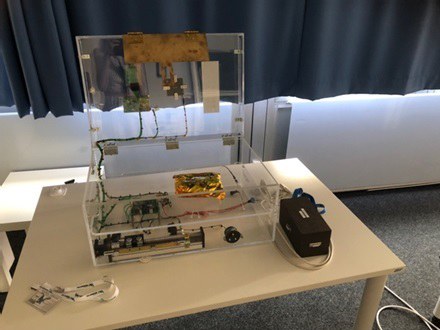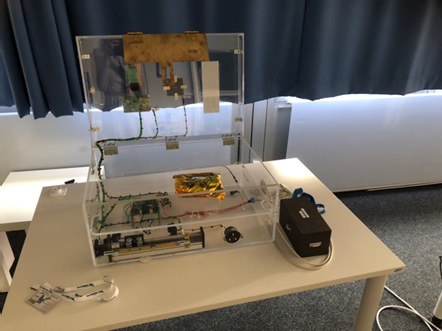CTRL+ESC: Control Theory Escape Room Development at TU Berlin
Activity Organizer
Steffi Knorn (Technical University of Berlin, Germany)
IFAC Sponsor: TC 9.4
Description:
Despite its great importance for virtually all fields of industry and manufacturing, control engineering and its underlying principles are unknown to the vast majority of people in the general public. While related fields like big data, machine learning, communications and artificial intelligence are emerging and experiencing a media hype, control is seldom mentioned - let alone its governing principles explained. But, in order to understand emerging technologies, which include an increasing amount of control, people must at least develop a general understanding of the principles and basic concepts in control.
Storyline:
- During a holiday the group of participants visit an observatory and as they walk through the hallways they hear a professor call for help. The professor explains that they are being hacked and need the participants help to retrieve a reset code from a safe in their home. However, as the professor needs to continue to defend the attack, the instructions given to the participants are brief and incomplete, the professor is, however, very clear that the reset code is needed within one hour!
- As the observatory is situated in an isolated area and on a high altitude, the first puzzle needing to be solved is to fly a helicopter from the observatory to the base station. Unfortunately, the hackers have compromised the helicopter and the pilot is unable to see neither position nor velocity from the pilot's seat, i.e., one participant needs to act as a feedback coupling to the pilot. As the vehicle lands in the correct location, the system equation is revealed.
- From the base station, the participants must use a self-driving vehicle to take them back to the city. As the vehicle is being developed by the professor themselves, it is not yet complete. First, the participants need to verify the programmed trajectory, by solving a given system. As the participants realize that the planned trajectory is unstable, they need to find a suitable controller to alter the trajectory. Through the designed controller, the vehicle stops and reveals the next address.
- As the vehicle enters the city, the participants encounter a traffic zone in which no autonomous driving is allowed. Therefore, the participants need to find the destination by backtracking a recording of the last trip, i.e., the participants receive the input to the vehicle and will act as an observer in order to find the initial state.
- Finally, the participants arrive at the street of the professor. They realise that they don't know the street number of the particular house and try to contact the professor in order to get some directions. The professor replies that the participants will find the house if they walk for two minutes with a specific speed and then hangs up the telephone before more specific information can be given.
- As they finally enter the house, the participants notice that the children of the professor have been home alone for some time and created a number of riddles that the participants must solve in order to get to the safe.
- First, the participants have to mimic the buzzing sound of the door opener by combining different pure sinusoidal sound waves in the correct way to open the front door. In order to get past a second door, to enter the professor's office, they need to retrieve an RFID-token from a key box, designed as a levitating magnet. To be able to reach the token, the participants need to find the correct PID-controller-parameters to make the token levitate at the desired height.
- As the participants enter the office, they realize that they need a solution to carry the token on their head and hence have to choose a suitable hat. With their hands free, the participants can now solve the next puzzle by recreating a signal hidden within a wooden box. Finally, the participants need to solve the code for the safe. This is done by solving a regression problem.
Puzzles included:
The list below gives an overview of the included concepts and some information about the associated puzzles in CTRL+ESC. After solving a puzzle, a respective code is provided and the accumulation of these codes can be entered sequentially into the final treasure chest to reveal the reset code for the Professor, marking the completion of the escape room.
- control loop: the terms denoting standard parts of a control loop have to be connected (via cables) to the correct node of the control loop
- feedback: one participant acts as the feedback of the position to another participant, whom controls a helicopter by a joystick
- dynamic systems: the trajectory in a 2D-grid has to be found for a given system equation to track the movement of an object
- stability: relating a selection of hats with different shapes (concave, convex, flat) to allow one to balance an object on the hat
- observer: find the initial state (location) of a system through the use of a known endpoint and recorded inputs
- frequency analysis: a sound made out of single-frequency tones has to be rebuilt by choosing appropriate amplitudes of the frequency components
- sampling: feeling a curve in a dark box by hand and rebuilding it by placing loose pins of different heights in the appropriate order
- aliasing: finding the walking speed along a street of a person looking to the side periodically & making conclusions about all houses
Deployment:
The puzzles were transported to HAW Hamburg for ACE2022 in order to give conference participants and local students a chance to play the room and hence experience the room. A total of 9 groups took the opportunity, most completed the puzzles but many also needed assistance and help to solve some of the puzzles. Overall, the reception was very positive with some criticism due to language difficulties (non-native speakers expressed some difficulties understanding the English texts).
Several colleagues expressed interest in extending the puzzles and establishing similar escape rooms at their local institutions.
All equipment was transported back to Berlin after ACE in Hamburg and then set up at a dedicated room belonging to the control group of the applicant at TU Berlin. During the autumn/winter semester 2022/23 (starting in October 2022), students taking the control course will be invited to solve/play CTRL+ESC in order to enhance their interest in control and increase their self-efficacy.
However, in order to fully establish the room and open it to the general public, additional funds must be acquired as legal constraints prevent us from employing student assistants to look after CTRL+ESC.



